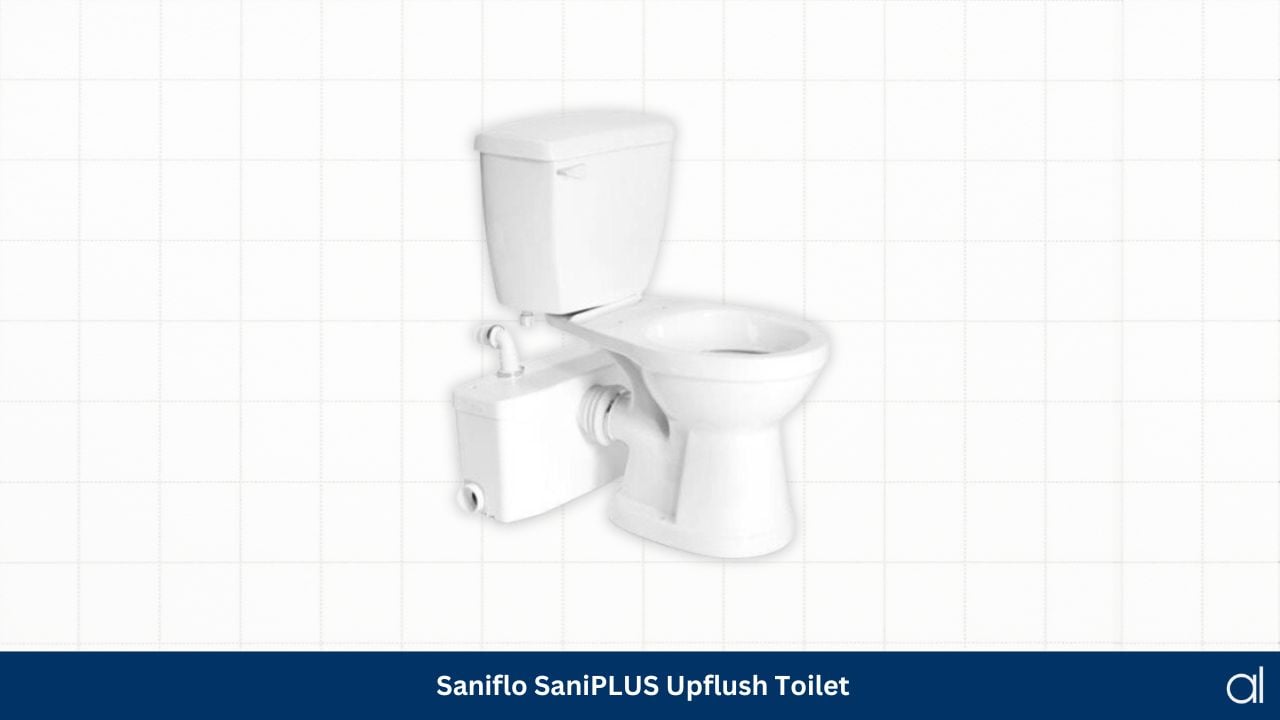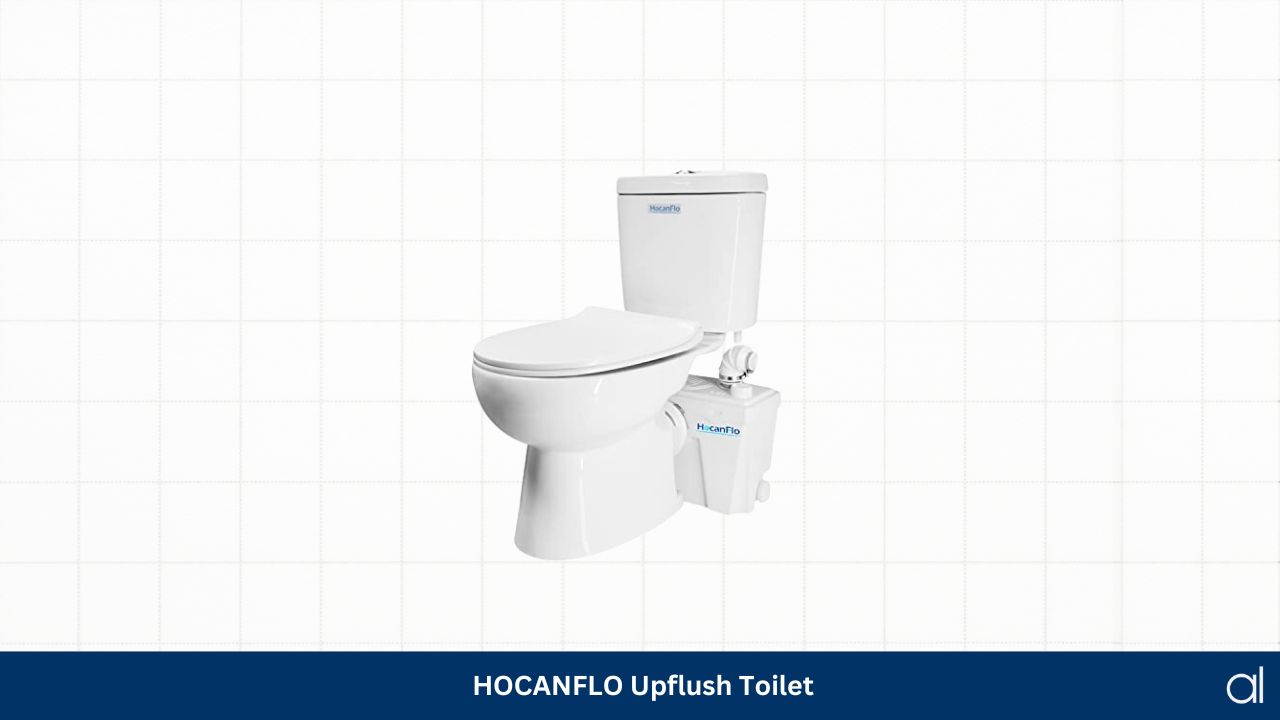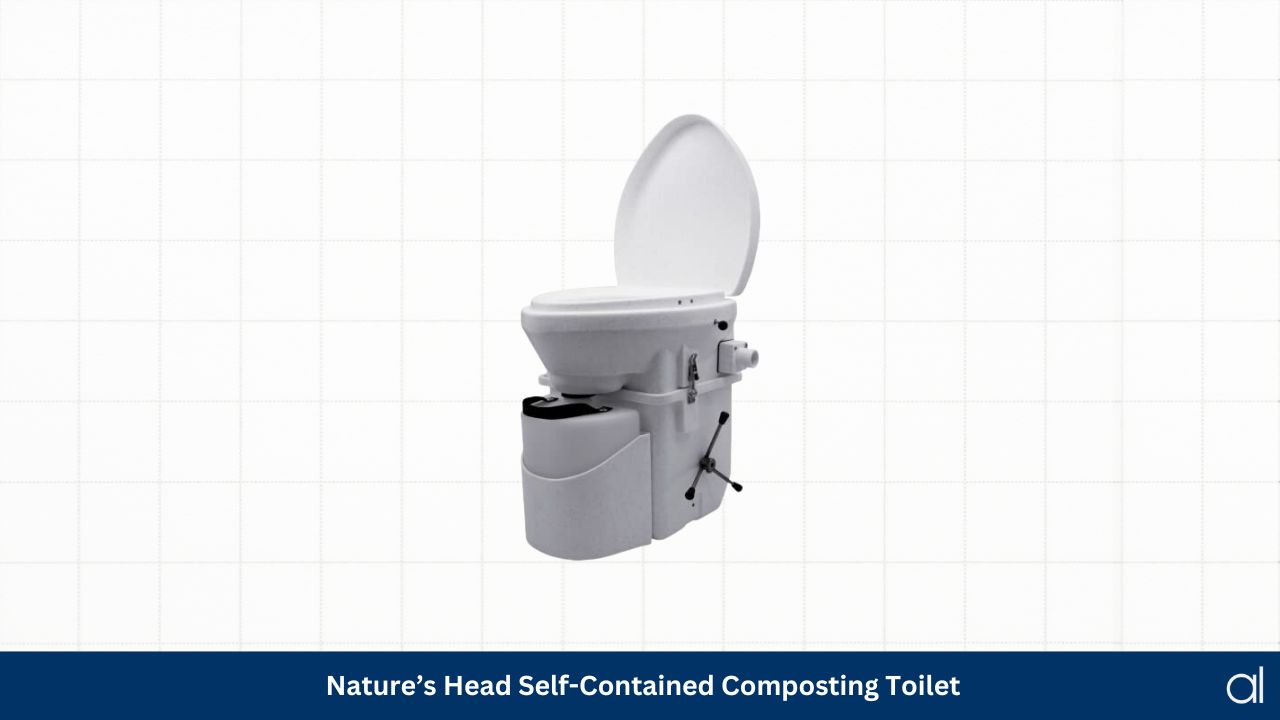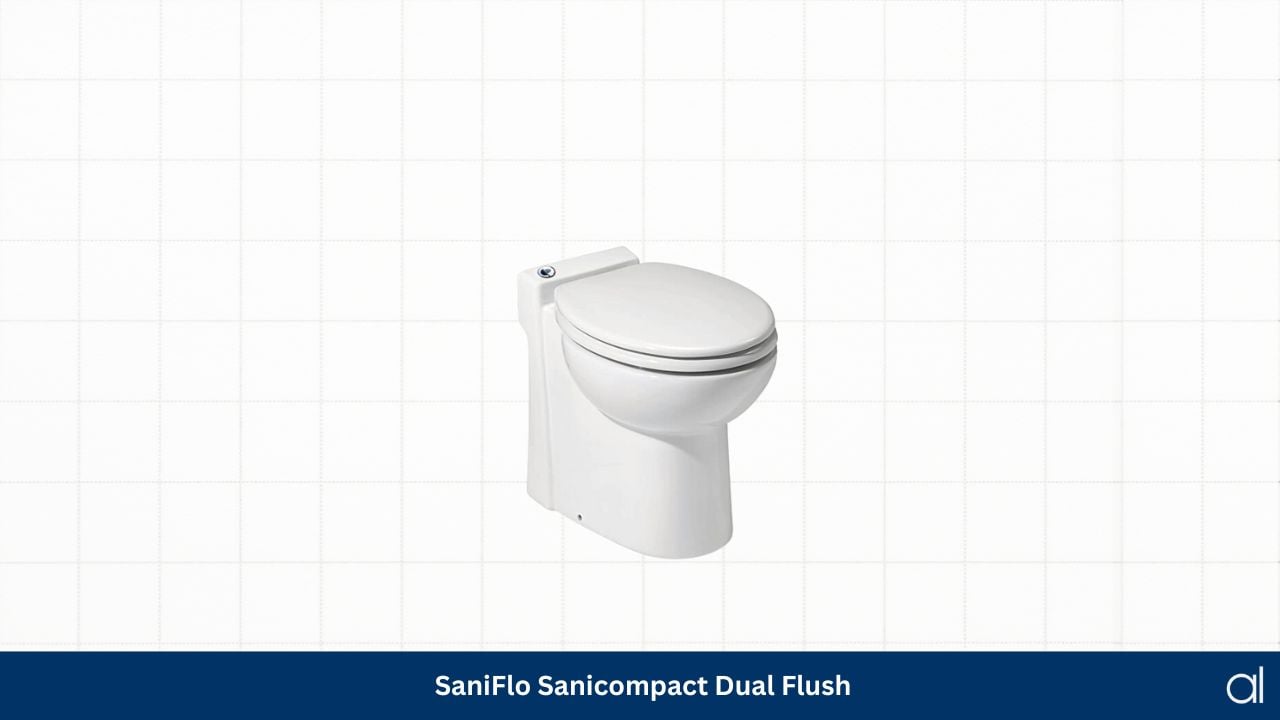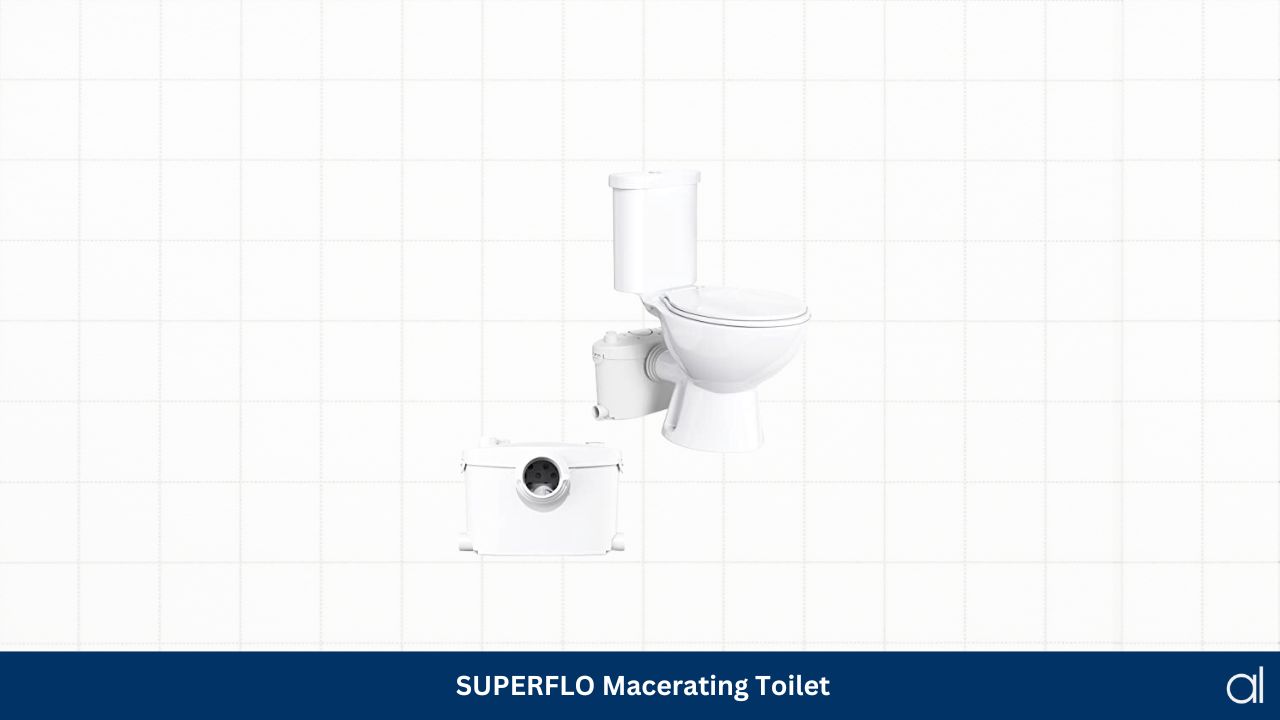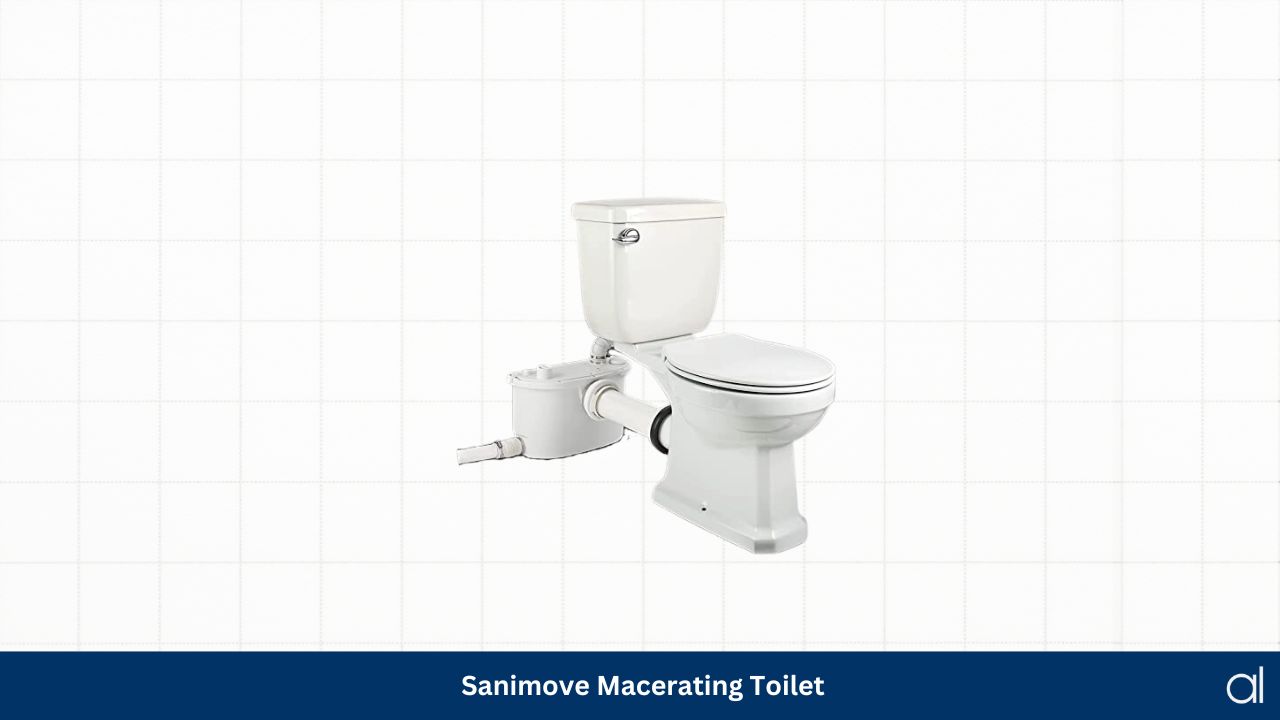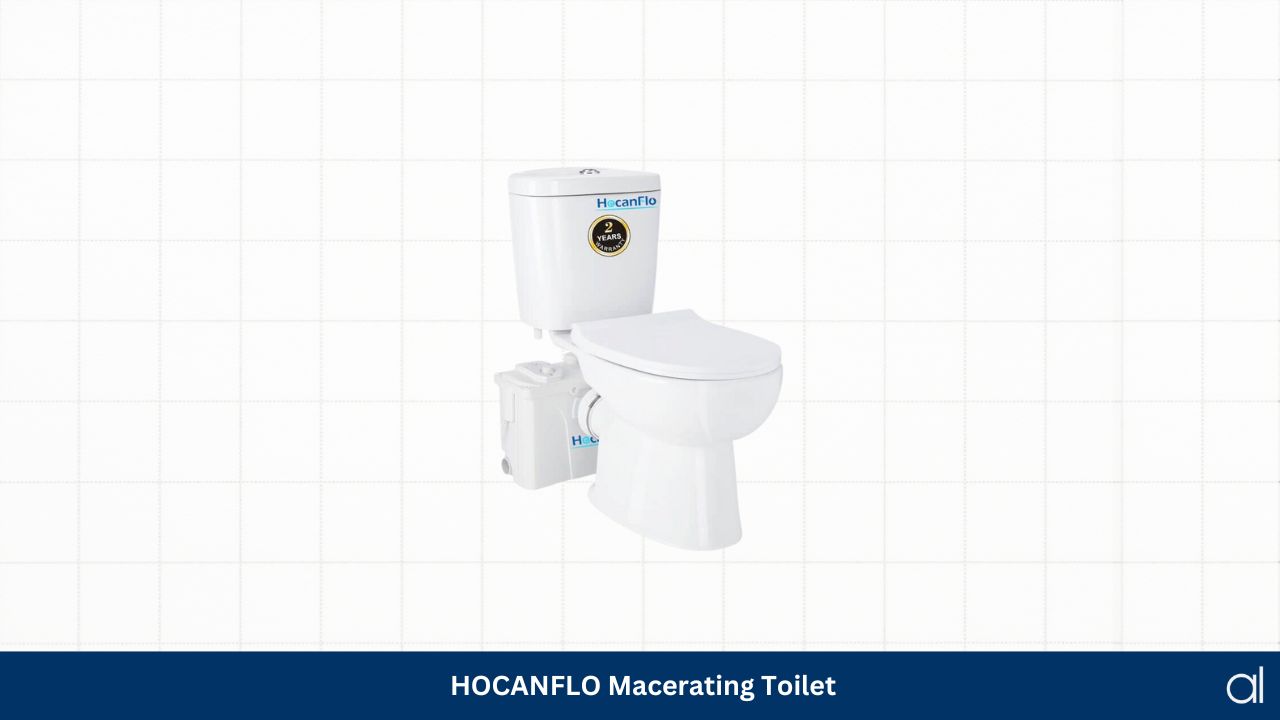Having a toilet in the basement can be quite convenient, especially if the basement is used frequently.
While it may seem like a simple affair, having a toilet installed in the basement bathroom can be more complicated because of the plumbing system. Because of this, not all toilet options are ideal for the basement, which can make choosing one difficult.
So, here are our recommendations for the seven best toilets for basement bathrooms.
Top 7 Toilets for Basement Reviewed
1. Best Overall: Saniflo SaniPLUS Upflush Toilet
The Saniflo SaniPLUS is a macerating toilet kit that can be installed in your bathroom without having to break the basement flooring up. Along with the toilet bowl, this kit includes a bathroom pump and a white toilet tank in the packaging box.
To install the SaniPLUS floor or wall-mounted toilet, you must install no more than four connections in the drainage system. Once the connections have been made, connect the drainage system to the spigot of the toilet, electric supply, water supply, and small-diameter discharge pipe.
During our tests, we found that the pressure chamber used in the toilet system is quite efficient. The electric motor used in the toilet activates with no delay once the flush lever is pulled down during use.
Additionally, the stainless steel macerator blades in the pump can blend the waste into a slurry to be discharged into the septic system. The blades can rotate at 3,600 RPM, which is high enough for this process to be rather quick.
We did find that the toilet tank that comes with SaniPLUS may be a little unstable when used. While this issue did not present itself frequently, it is worth noting nonetheless.
What We Like
- Quick and easy installation
- High RPM macerator blades
- Fast-acting pump motor
- Installation doesn’t need breaking the floor up
What We Don’t Like
2. Easiest to Install Upflush Toilet Pump: HOCANFLO Upflush Toilet
If your basement plumbing regularly experiences low water pressure, the HOCANFLO up flush toilet may be an option to consider. The macerating toilet aims to be an economical and space-saving toilet that easily fits in a basement bathroom.
This toilet can be paired with a plumbing system that has narrow piping as well. With its 500-watt pump, the toilet can force effluent upward to 22.9 feet and 229 feet horizontally.
It also comes with four water inlets, allowing you to install it to multiple water sources simultaneously. Combined with a water consumption rate of 1.6 gallons per flush, the toilet can be quite water-efficient.
The HOCANFLO toilet can be installed behind the toilet or the wall, making its installation flexible. Additionally, the installation process is as simple as a standard toilet, which may be preferable for those familiar with the process.
While testing the toilet, we found occasional humming noises from the pump, which may be a little concerning in the long run.
What We Like
- Flexible installation process
- Powerful 500-watt pump
- Four water inlets
- Low water consumption per flush
What We Don’t Like
3. Best Composting Toilet for Basements: Nature’s Head Self-Contained Composting Toilet
For those who would prefer a quick-to-use toilet with an easy installation process, the self-contained composting toilets from Nature’s Head may be for you.
Nature’s Head Self-Contained Composting Toilet does not involve any plumbing at all and can be placed anywhere in the bathroom. If you have a plumbing system that cannot be adjusted easily, this toilet may circumvent the costly bathroom renovations altogether.
The toilet uses a composting medium that must be cleaned out once every two weeks. This medium is typically soil made specifically for composting purposes, which, unlike garden soil, does not cause the toilet to smell.
Additionally, the toilet is structured to keep the solid and liquid wastes in a separate unit. Once the toilet has been used, you must turn the handle to empty the waste into solid and liquid waste tanks. You may keep an eye on the waste tanks to know exactly when to empty it.
It’s worth noting that the toilet can rack up on the toiletry expenses with regular composting medium purchases. This is on top of its already high cost, which may not be desirable for all.
What We Like
- Can be placed anywhere
- Quick and easy to set up
- Does not produce a foul odor
- Minimal water usage
What We Don’t Like
4. Best Basement Toilet Flush System: SaniFlo Sanicompact Dual Flush
The Saniflo Sanicompact toilet is a model designed to save as much bathroom space as possible. This is an efficient basement toilet that uses dual flush toilet technology for high water efficiency.
Employing a dual-flush self-contained toilet system, the Sanicompact can be installed if the half bathroom is up to 9 feet below the sewage line. Moreover, the toilet can also be placed up to 120 feet from a soil stack, giving it plenty of flexibility in terms of positioning.
Its standard dual flush uses 1.28 gallons per flush with the same flushing power as a regular toilet. This can reduce even further, up to a single gallon per flush, making it highly water-efficient.
The Sanicompact is a gravity-flush toilet, meaning that it functions largely the same as a regular toilet. This can potentially limit its usefulness in a basement bathroom, depending on how far the sewer line is. Should the city sewer line be more than 9 feet above the basement ceiling, it may not be as effective at its job.
What We Like
- Effective dual-flush system
- Can be positioned flexibly
- Highly water efficient
- Can be used to install a half-bathroom
What We Don’t Like
5. Quietest Upflush Basement Toilet: SUPERFLO Macerating Toilet
Boasting a high-power motor, the SUPERFLO upflush toilet is designed to be water-efficient, easy to install, and space-saving.
The toilet comes with a 600W macerator pump that can pump sewage 32.8 feet and 263 feet horizontally. This sewage ejector system can suit houses with low water pressure, narrow pipes, or toilets located beneath the sewer lines.
And combined with noise-reduction capabilities, the SUPERFLO toilet may be an option that suits a basement bathroom. It produces 45-50 dB sounds while operating, which is only as loud as an ordinary office conversation.
It can also come with an optional activated carbon ventilation system to get rid of any odor. For this to work, you must connect the toilet to the household ventilation system through the vent atop the pump.
Additionally, it includes a pressure chamber with internal starting and stopping devices. This can be activated or deactivated based on the water pressure and level.
It’s worth noting that if you need to repair the toilet or its systems at any point, finding parts for the SUPERFLO may be difficult.
What We Like
- 600W motor
- Low operation sounds
- Reduces odor through the ventilation system
- Includes a pressure chamber
What We Don’t Like
6. Easiest to Maintain Upflush Toilet: Sanimove Macerating Toilet
The Sanimove Macerating Toilet is an up flush toilet designed to be used in the basement without producing much noise. It comes with a 500W pump that can siphon liquid and solid waste 21 feet vertically and 197 feet horizontally.
With its high power, the toilet is capable of transporting wastewater quickly against gravity. This makes it suited for the basement bathroom, where the sewer line is typically high above the toilet. The pump does not make much noise and can be installed quite easily without help from a plumber.
Additionally, the pump features four water inlets that connect to multiple devices, including the shower, toilet, bathtub, bathroom sink, and bidet. This allows you to pump wastewater from all drain points in the basement bathroom, which can be convenient.
The elongated toilet bowl features a nano-glaze that reduces how frequently you need to clean it. It prevents the growth of water scale and mineral stains as well, making it easier to maintain.
During tests, we did find that the toilet vibrated once in a while, accompanied by a loud noise. This can be a little concerning but can be solved by manually rotating the blades while the macerator is turned off.
What We Like
- 500W pump
- Can transport waste quickly
- Connects up to four devices
- Nano-glaze on the toilet bowl
What We Don’t Like
7. Most Powerful Macerator Pump: HOCANFLO 700W Macerating Toilet
Basements that are far beneath the sewer lines would require a powerful macerating pump to pump the waste vertically. And that is what the HOCANFLO Macerating Toilet aims to achieve.
Featuring a 700W macerator pump, the toilet can push waste up to 29.5 feet vertically and 328 feet horizontally. So, no matter how deep the basement is, this sewage ejector system can pump the waste to the main sewer line without issues.
Additionally, the pump operates without making a harsh noise, preventing a nasty echo from permeating the basement. Its stainless steel, non-clog blades can effectively blend human waste and toilet paper into a fine slurry before pumping it into a stack.
The HOCANFLO Macerating Toilet comes with four inlet connections, allowing you to connect to multiple sanitary devices. It also features automatic wastewater detection, which turns the pump on once the septic tank fills up to a certain degree.
A low humming noise did come to our notice while testing the product occasionally, which can be a point of concern.
What We Like
- 700W motor
- Four inlet connections
- Automatic wastewater detection
- High waste maceration efficiency
What We Don’t Like
Best Basement Toilets Comparison Table
| Product | Toilet Type | Installation Type | Toilet Bowl Shape | Water Consumption |
|---|---|---|---|---|
| Saniflo SaniPLUS Upflush Toilet | Upflush Toilet | Floor-mounted, wall-mounted | Elongated | 1.6 gallons per flush |
| HOCANFLO Upflush Toilet | Upflush toilet | Wall-mounted | Round | 1.6 gallons per flush |
| Nature’s Head Self-Contained Composting Toilet | Composting toilet | Flexible | Elongated | N/A |
| SaniFlo Sanicompact Dual Flush | Gravity Toilet | Floor-mounted | Elongated | 1-1.28 gallons per flush |
| SUPERFLO Macerating Toilet | Upflush Toilet | Floor-mounted | Oblong | 1.59 gallons per flush |
| Sanimove Macerating Toilet | Upflush toilet | Floor-mounted | Elongated | 1.28 gallons per flush |
| HOCANFLO 700W Macerating Toilet | Upflush Toilet | Floor-mounte | Elongated | 1.6 gallons per flush |
Buyer’s Guide
For those who have a bedroom in the basement or use it frequently for recreational purposes, having a toilet can be quite useful.
Contrary to what one may believe at first glance, having a toilet installed in the basement can be a rather complex affair. The primary hurdle to consider when choosing a basement toilet is the plumbing layout of your home.
Based on the plumbing layout, most toilets cease to work as effectively. As such, it’s important to know both the plumbing type and the kind of toilet you will be purchasing for the basement bathroom.
In addition to the plumbing layout, you must also consider secondary factors like water efficiency, noise rate, toilet shape, and more. These factors can narrow down your choices of the best basement toilets considerably to suit your needs the best.
So, let’s look at the factors to look for when choosing a basement toilet.
1. The Toilet Type
Chiefly, there are three types of permanent toilets that you may install in the basement, namely gravity toilets, upflush or macerating toilets, and pressure-assisted toilets. Each of these has varying degrees of effectiveness in the basement, which is why choosing between them can be difficult.
A. Gravity Toilets
Gravity toilets are standard toilets that can be found in the master bedroom of your home.
Toilets are largely dependent on the plumbing to function, which is usually the case with standard toilets. Working in tandem with gravity, such toilets flush the waste from the toilet bowl and into the drain without requiring any additional basement floor space.
The trouble with using standard gravity toilets in the basement bathroom is that plumbing often does not reach far enough beneath the toilet seat. This may negate the gravity-based draining function that such toilets rely on, making them a poor fit for basements.
B. Upflush Toilets
An up flush or macerating toilet can suit a toilet well if the sewerage pipes are above the basement bathroom floor. These models siphon the toilet waste through the rear and into a holding tank.
This tank has a macerator and pump that, once it fills up to a certain level, empties the waste into the sewage system. Such toilets can dispose of both human waste and toilet paper, with certain models being able to handle larger feminine hygiene products like sanitary napkins.
These toilets don’t require a sanitary sewer to be installed, which keeps the installation process simple and convenient. The tank can be fitted inside or behind a wall in the basement, which can further save floor space in your basement bathroom.
That said, these toilets can be rather noisy because of the pump present in the tank. Models with a grinder pump can be even noisier, which may echo harshly in the basement.
C. Pressure-Assisted Toilets
Pressure-assisted toilets are similar to regular toilets in all aspects but one: the utilization of air pressure. These toilets have a second tank inside the main toilet tank that maintains the additional atmospheric pressure to propel waste to the sewer line.
Since these toilets primarily use air pressure to dispose of waste, they are highly water-efficient, which can be a boon for your utility bills. Moreover, a pressure-assisted toilet flushes quickly and with more force than a standard toilet, which helps to keep the toilet bowl clean.
Note that much like up flush or macerating toilets, a pressure-assisted toilet can be very loud while flushing. These toilets can also be quite difficult to fix should something go awry with their inner workings.
2. Toilet Shape
Primarily, there are two kinds of toilet seat shapes: round bowl and elongated bowl. Elongated toilets are often more comfortable to sit on, while round ones take up less space and can serve as a corner toilet.
Choosing one or the other toilet seat depends solely on whether you want it to take up minimal space or have a more comfortable toilet experience.
3. Noise Levels
As mentioned earlier, both upflush and pressure-assisted toilets make a lot of noise while flushing.
Upflush or macerating toilets may make more noise when the pump is operational, which only engages once the toilet tank is filled up to a certain level. On the other hand, pressure-assisted toilets are noisy during regular flushing as well.
You may choose between one or the other based on the noise levels indicated in the manufacturer’s specifications. It may also be worth considering soundproofing solutions if the toilet of your choice is quite noisy.
4. Water-Efficiency
How much water a toilet uses per flush can affect your water bills quite drastically. A standard toilet brand like Kohler can flush away up to 1.6 gallons per flush, with an ultra-high-efficiency toilet using no more than 0.8 gallons.
Be sure to check the water efficiency rating of the toilet before purchasing one.
What is the best type of toilet to use in a basement?
The best toilet for a basement bathroom is the up flush toilet. These toilets require little or no bathroom readjustments to install and connect seamlessly to the existing plumbing system.
Moreover, they are less expensive and easier to install than pressure-assisted toilets, which can be favorable for those without experience installing toilets.
Can standard toilets be installed in the basement?
A standard toilet may work in the basement, provided that the sewer line is not too far above the room. However if the sewer line is far above the basement toilet, a standard toilet will require adjustments to the plumbing system to function correctly. Thus, you will need to install a special toilet to have no issues using it in the basement.
What can cause basement toilets to smell?
The buildup of limescale and human waste can be the reason for basement toilets to smell. Cleaning the toilet bowl once every few weeks will prevent this smell entirely.
Does an upflush toilet need electricity?
Upflush toilets include a macerator pump that needs power to operate. These pumps need to be connected to the power supply of your home for the system to work as intended.
Based on our time testing the toilets, we found that the Saniflo SaniPLUS Upflush Toilet is the best toilet for a basement. It is an easy-to-install kit that comes with a powerful macerator pump that acts quickly with no issues.
That said, you may also consider the HOCANFLO Upflush Toilet and Nature’s Head Self-Contained Composting Toilet, based on where the basement is located. The former can be an economical basement toilet, whereas the latter can reduce water consumption significantly.
At the end of the day, the most suitable toilet for you depends on what you need from it.
Related Articles
10 Best Corner Toilets for Small Bathrooms

